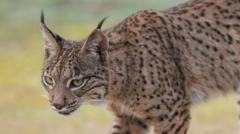The Iberian lynx, marked by its distinctive leopard-like spots, is beginning to reclaim its place in the wild. Notably, Navarro, a male lynx, was spotted during the mating season by a camera trap. Stretching to nearly 100 cm (39 inches) and standing about 45 cm tall, these elusive creatures, once nearing extinction, now boast a rising population of over 2,000 across Spain and Portugal—a notable increase from just two decades ago.
Rodrigo Serra, manager of the lynx reproduction programme, emphasizes that the Iberian lynx was perilously close to disappearing, with fewer than 100 individuals left in isolated populations at one point. A mere 25 of these were females capable of breeding. This alarming decline mirrored historical threats faced by feline species, such as the ancient sabre tooth tiger.
Several factors contributed to the lynx's plight, including agricultural expansion, road fatalities, and significant drops in their primary food source—wild rabbits. A pair of pandemics decimated rabbit numbers by 95%, exacerbating the lynx's survival challenges. Although Portugal had no lynxes left by 2005, Spain saw the first successful captive breeding that year. In response, Portugal launched a national conservation plan and established a breeding center in Silves, Algarve, where the lynxes receive round-the-clock monitoring.
The center focuses on preparing lynxes for a life in the wild, employing techniques such as inducing stress to make them wary of human encounters. "A lynx should be a lynx," Serra says, underscoring the goal of preventing them from associating food with people. Using a tunnel system, they are fed without human contact until their eventual release.
Reintroduction efforts prioritize genetic diversity, ensuring that lynxes born in Portugal may be relocated to Spain to mitigate the risks of inbreeding. Pedro Sarmento, who has studied the species for 30 years, has been integral to these initiatives. Handling lynxes reveals their unique physical traits—small heads and broad paws facilitate remarkable jumping abilities.
Despite the successes of the breeding program, the increasing population is not without complications. Many lynxes are released on private lands, necessitating agreements with landowners. Some have caused minimal disturbance by targeting chicken coops. To address this, the conservation team is reinforcing coops and monitoring lynx movements to discourage such behavior.
One notable lynx named Lítio illustrates the challenges of reintroduction. After initially disappearing, Lítio made a remarkable journey back to his original habitat in Doñana National Park before returning to the Algarve, where he began to thrive and father numerous cubs.
Three decades post-initiation of conservation efforts, the Iberian lynx's status has shifted significantly. With a current population of over 2,000, there is optimism that by 2035, numbers could reach the 5,000 to 6,000 range needed for a favorable conservation status. Despite the lingering threats posed by road fatalities, conservationists like Serra now regularly witness the once-endangered species thriving in their natural habitats.






















